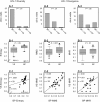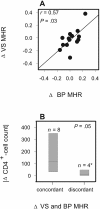Diversity, divergence, and evolution of cell-free human immunodeficiency virus type 1 in vaginal secretions and blood of chronically infected women: associations with immune status
- PMID: 16014941
- PMCID: PMC1181596
- DOI: 10.1128/JVI.79.15.9799-9809.2005
Diversity, divergence, and evolution of cell-free human immunodeficiency virus type 1 in vaginal secretions and blood of chronically infected women: associations with immune status
Abstract
Most human immunodeficiency virus type 1 (HIV-1) infections are believed to be the result of exposure to the virus in genital secretions. However, prevention and therapeutic strategies are usually based on characterizations of HIV-1 in blood. To understand better the dynamics between HIV-1 quasispecies in the genital tract and blood, we performed heteroduplex assays on amplified env products from cell-free viral RNA in paired vaginal secretion (VS) and blood plasma (BP) samples of 14 women followed for 1.5 to 3.5 years. Diversity and divergence were less in VS than in BP (P = 0.03 and P < 0.01, respectively), and divergence at both sites was correlated with blood CD4(+) cell levels (VS, P = 0.05; BP, P = 0.01). Evolution of quasispecies was observed in 58% of the women; the loss or gain of quasispecies in VS or BP was always accompanied by such changes at the other site. In addition, sustained compartmentalization of quasispecies in VS was found for four women, even as CD4(+) cell levels decreased to low levels (<50 cells/microl). Quasispecies changes over time were associated with fluctuations in CD4(+) cell levels; concordant increases or decreases in VS and BP divergence had greater CD4(+) cell level changes than intervals with discordant changes (P = 0.05), and women with evolving quasispecies had greater decreases in CD4(+) cell levels compared to that for women who maintained the same quasispecies (P < 0.05). Thus, diversity, divergence, and evolution of cell-free HIV-1 in VS can be different from that in BP, and dynamics between their respective quasispecies are associated with changes in CD4(+) cell levels.
Figures






Similar articles
-
Female genital tract shedding of CXCR4-tropic HIV Type 1 is associated with a majority population of CXCR4-tropic HIV Type 1 in blood and declining CD4(+) cell counts.AIDS Res Hum Retroviruses. 2012 Nov;28(11):1524-32. doi: 10.1089/AID.2012.0004. Epub 2012 Mar 23. AIDS Res Hum Retroviruses. 2012. PMID: 22369497 Free PMC article.
-
Genital tract human immunodeficiency virus type 1 (HIV-1) shedding and inflammation and HIV-1 env diversity in perinatal HIV-1 transmission.J Infect Dis. 2000 Feb;181(2):555-63. doi: 10.1086/315230. J Infect Dis. 2000. PMID: 10669339
-
Highly divergent patterns of genetic diversity and evolution in proviral quasispecies from HIV controllers.Retrovirology. 2017 May 2;14(1):29. doi: 10.1186/s12977-017-0354-5. Retrovirology. 2017. PMID: 28464889 Free PMC article.
-
Quasispecies tropism and compartmentalization in gut and peripheral blood during early and chronic phases of HIV-1 infection: possible correlation with immune activation markers.Clin Microbiol Infect. 2014 Mar;20(3):O157-66. doi: 10.1111/1469-0691.12367. Epub 2013 Oct 18. Clin Microbiol Infect. 2014. PMID: 24134524
-
Human immunodeficiency virus type 1 quasispecies in vivo and ex vivo.Curr Top Microbiol Immunol. 1992;176:181-93. doi: 10.1007/978-3-642-77011-1_12. Curr Top Microbiol Immunol. 1992. PMID: 1600752 Review. No abstract available.
Cited by
-
Comparative study of methods for detecting sequence compartmentalization in human immunodeficiency virus type 1.J Virol. 2007 Jun;81(12):6643-51. doi: 10.1128/JVI.02268-06. Epub 2007 Apr 11. J Virol. 2007. PMID: 17428864 Free PMC article.
-
Local replication of simian immunodeficiency virus in the breast milk compartment of chronically-infected, lactating rhesus monkeys.Retrovirology. 2010 Feb 1;7:7. doi: 10.1186/1742-4690-7-7. Retrovirology. 2010. PMID: 20122164 Free PMC article.
-
Evidence for both Intermittent and Persistent Compartmentalization of HIV-1 in the Female Genital Tract.J Virol. 2019 May 1;93(10):e00311-19. doi: 10.1128/JVI.00311-19. Print 2019 May 15. J Virol. 2019. PMID: 30842323 Free PMC article.
-
Cervical shedding of HIV-1 RNA among women with low levels of viremia while receiving highly active antiretroviral therapy.J Acquir Immune Defic Syndr. 2007 Jan 1;44(1):38-42. doi: 10.1097/01.qai.0000248352.18007.1f. J Acquir Immune Defic Syndr. 2007. PMID: 17106279 Free PMC article.
-
Correlation between CD4 T cell counts and virus compartmentalization in genital and systemic compartments of HIV-infected females.Virology. 2011 Sep 1;417(2):320-6. doi: 10.1016/j.virol.2011.06.018. Epub 2011 Jul 13. Virology. 2011. PMID: 21745672 Free PMC article.
References
-
- Albert, J., B. Abrahamsson, K. Nagy, E. Aurelius, H. Gaines, G. Nystrom, and E. M. Fenyo. 1990. Rapid development of isolate-specific neutralizing antibodies after primary HIV-1 infection and consequent emergence of virus variants which resist neutralization by autologous sera. AIDS 4:107-112. - PubMed
-
- Altfeld, M., E. S. Rosenberg, R. Shankarappa, J. S. Mukherjee, F. M. Hecht, R. L. Eldridge, M. M. Addo, S. H. Poon, M. N. Phillips, G. K. Robbins, P. E. Sax, S. Boswell, J. O. Kahn, C. Brander, P. J. R. Goulder, J. A. Levy, J. I. Mullins, and B. D. Walker. 2001. Cellular immune responses and viral diversity in individuals treated during acute and early HIV-1 infection. J. Exp. Med. 193:169-180. - PMC - PubMed
-
- Arendrup, M., C. Nielsen, J.-E. S. Hansen, C. Pedersen, L. Mathiesen, and J. O. Nielsen. 1992. Autologous HIV-1 neutralizing antibodies: emergence of neutralization-resistant escape virus and subsequent development of escape virus neutralizing antibodies. J. Acquir. Immune Defic. Syndr. 5:303-307. - PubMed
-
- Artenstein, A. W., T. C. VanCott, K. V. Sitz, M. L. Robb, K. F. Wagner, S. C. D. Veit, A. F. Rogers, R. P. Garner, J. W. Byron, P. R. Burnett, and D. L. Birx. 1997. Mucosal immune responses in four distinct compartments of women infected with human immunodeficiency virus type 1: a comparison by site and correlation with clinical information. J. Infect. Dis. 175:265-271. - PubMed
-
- Belec, L., T. Dupre, T. Prazuck, C. Tevi-Benissan, J.-M. Kanga, O. Pathey, X.-S. Lu, and J. Pillot. 1995. Cervicovaginal overproduction of specific IgG to human immunodeficiency virus (HIV) contrasts with normal or impaired IgA local response in HIV infection. J. Infect. Dis. 172:691-697. - PubMed
Publication types
MeSH terms
Substances
Grants and funding
LinkOut - more resources
Full Text Sources
Medical
Research Materials

